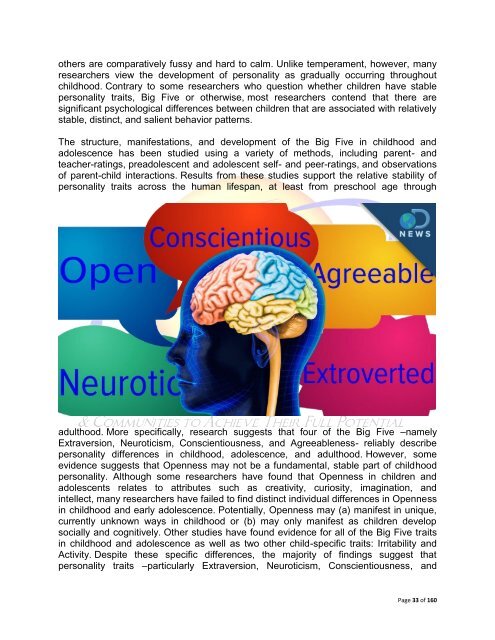The Gift of Introversion
The Gift of Introversion
The Gift of Introversion
Create successful ePaper yourself
Turn your PDF publications into a flip-book with our unique Google optimized e-Paper software.
others are comparatively fussy and hard to calm. Unlike temperament, however, many<br />
researchers view the development <strong>of</strong> personality as gradually occurring throughout<br />
childhood. Contrary to some researchers who question whether children have stable<br />
personality traits, Big Five or otherwise, most researchers contend that there are<br />
significant psychological differences between children that are associated with relatively<br />
stable, distinct, and salient behavior patterns.<br />
<strong>The</strong> structure, manifestations, and development <strong>of</strong> the Big Five in childhood and<br />
adolescence has been studied using a variety <strong>of</strong> methods, including parent- and<br />
teacher-ratings, preadolescent and adolescent self- and peer-ratings, and observations<br />
<strong>of</strong> parent-child interactions. Results from these studies support the relative stability <strong>of</strong><br />
personality traits across the human lifespan, at least from preschool age through<br />
adulthood. More specifically, research suggests that four <strong>of</strong> the Big Five –namely<br />
Extraversion, Neuroticism, Conscientiousness, and Agreeableness- reliably describe<br />
personality differences in childhood, adolescence, and adulthood. However, some<br />
evidence suggests that Openness may not be a fundamental, stable part <strong>of</strong> childhood<br />
personality. Although some researchers have found that Openness in children and<br />
adolescents relates to attributes such as creativity, curiosity, imagination, and<br />
intellect, many researchers have failed to find distinct individual differences in Openness<br />
in childhood and early adolescence. Potentially, Openness may (a) manifest in unique,<br />
currently unknown ways in childhood or (b) may only manifest as children develop<br />
socially and cognitively. Other studies have found evidence for all <strong>of</strong> the Big Five traits<br />
in childhood and adolescence as well as two other child-specific traits: Irritability and<br />
Activity. Despite these specific differences, the majority <strong>of</strong> findings suggest that<br />
personality traits –particularly Extraversion, Neuroticism, Conscientiousness, and<br />
Page 33 <strong>of</strong> 160

















